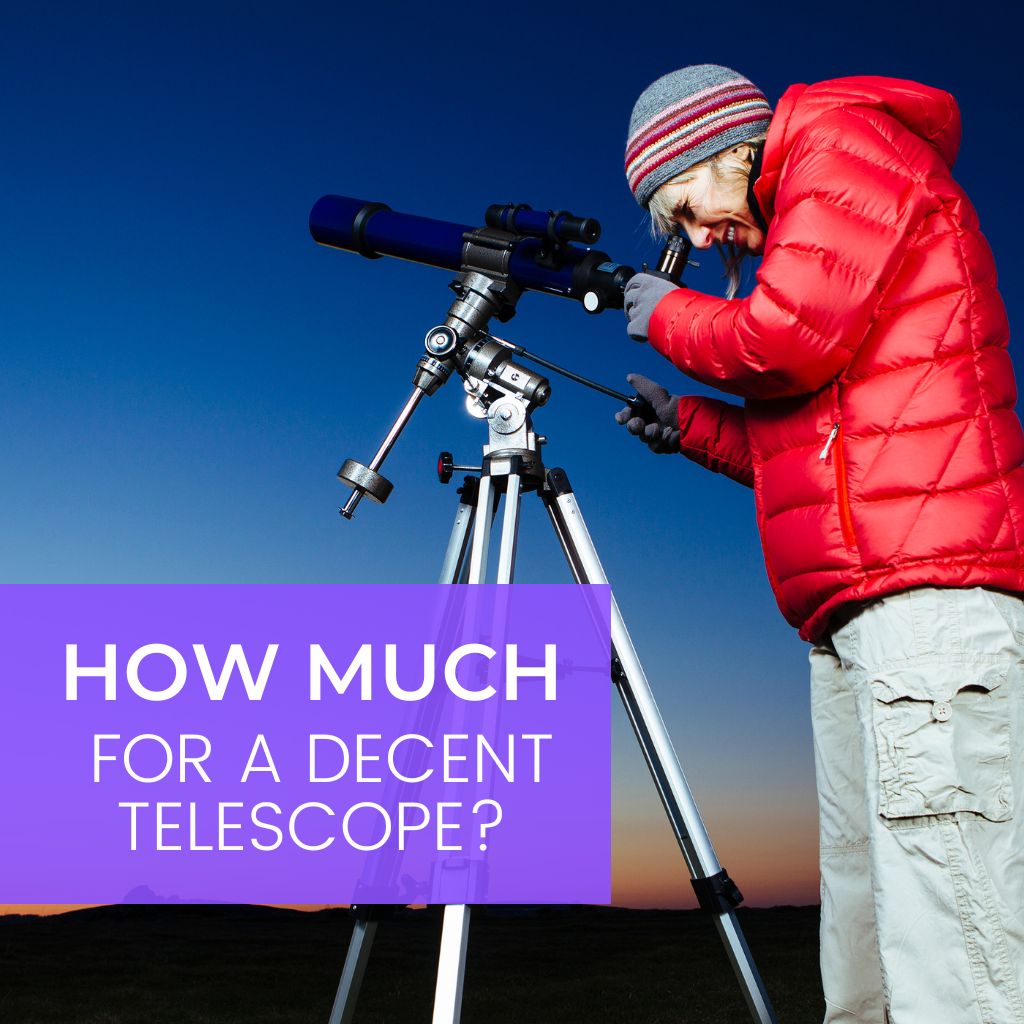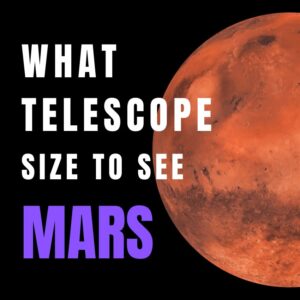This site contains affiliate links to products. I may receive a commission for purchases made through these links.
The amount you should spend on a decent telescope varies depending on your level of experience and the features you’re looking for. Entry-level telescopes can cost anywhere from $200 to $400, while intermediate telescopes can cost between $500 and $1,000. For more advanced telescopes, prices can range from $1,000 to $5,000 or more.
Investing in a telescope can greatly enhance your passion for astronomy.
However, before diving into the excitement, it’s important to determine the adequate amount to budget for your purchase. This will ensure you select a telescope that perfectly aligns with both your finances and level of fascination with stargazing.
Price is essential in purchasing a telescope, like every other product. In this case, the higher the price, the better the quality of the telescope and its capacity for deep-sky exploration. But there’s more to getting a telescope than knowing the price.
This article examines everything you need to know about the cost of a telescope, especially the amount you should spend to get a decent one based on your level of interest in stargazing.
Factors that influence the cost of a telescope
Several factors combine to influence the cost of a telescope. These factors help you understand the differences in their price, efficiency, and durability, and they include the following:
Quality of materials and manufacturing process
The quality of materials used for production determines the quality and cost of the product. Telescopes made with poor-quality materials are generally cheaper than those made with good materials. The manufacturing process also determines the quality and, consequently, the cost.
Getting a wobbly telescope made with cheap materials affects the quality of your experience.
It may seem like a cost-saving measure, but it could lead to additional expenses in the future, prompting you to buy another one.
As a result, you may experience prolonged dissatisfaction until you recognize the importance of prioritizing quality over cost.
Using an inexpensive telescope made from substandard materials can extinguish your passion for astronomy because it becomes challenging to spot celestial objects.
Size and complexity of the telescope
The size of a telescope significantly determines its efficiency and effectiveness. It dictates a telescope’s light-gathering ability, determining how clearly you see your celestial targets. Hence, the bigger the telescope size, the better the capacity and the higher the price.
A big telescope typically has more advanced specifications compared to a small telescope. In this case, the aperture – the diameter of a telescope’s lens – is bigger, allowing better image definition observed through the eyepiece under a night sky.
The size of a telescope also determines the focal length – the distance light rays travel between the aperture and the focuser – of the telescope. While a short focal length offers a wider field of view with tiny magnification, a long one offers great magnification despite having a smaller field of view.
The bigger a telescope’s size, the better it can absorb light, brightening images for a clearer view. So a general rule of thumb is: Bigger is always better.
Type of telescope and its features
The three major telescope types include refractors, reflectors, and catadioptric telescopes. The differences in these telescopes are determined by their features which inform their functions for space exploration. The function of each telescope determines the cost of purchasing one.
Refracting telescopes, which use lenses to focus light, are generally more expensive than their reflecting and catadioptric counterparts. This is because the process of creating high-quality lenses is more difficult and time-consuming, resulting in higher production costs.
Reflecting telescopes, which use mirrors to reflect and focus light, are generally more affordable than refractors due to the simplicity of their design.
Catadioptric telescopes, which use a combination of lenses and mirrors, fall somewhere between refractors and reflectors in terms of price.
In addition to the type of telescope, additional features, such as computerized tracking systems, also play a significant role in determining the price.
The more advanced the features, the more expensive they will be.
You may also like: Are GoTo Telescopes Worth It? (My Real Experience)
Brand reputation and customer support
The cost of a telescope is influenced by its brand reputation and the quality of its customer support. If a brand is known for producing quality telescopes and providing adequate support to customers for using them, more value is placed on their products than others.
Manufacturers and sellers determine the cost of a product based on its value, which increases with advanced features and functions.
Establishing a brand reputation requires consistent production of high-quality products that meet customer needs and maintaining that credibility over time.
Once a brand achieves this, it can command a higher price and still attract customers due to its popularity.
However, popularity alone does not guarantee product durability, which is why buyers should prioritize research on product quality and brand customer support before purchasing a telescope.
Availability and demand
The availability and demand of a product have a direct impact on its cost, including telescopes. If there is a surplus of telescopes in the market, the prices will drop, while the prices will increase if the demand for telescopes is high.
This will lead to changes in the pricing strategy adopted by the telescope brand.
As the brand gains popularity, the demand for their telescopes will rise, affecting both availability and cost. Higher prices may reduce consumer purchases, leading to limited supply and availability of the product.
You may also like:
The cost of additional accessories
In addition to the telescope purchased you’ll need accessories like eyepieces, filters, finderscope, Barlow lens, and telescope cover, among many others. These accessories are required for you to enhance your stargazing experience.
The inclusion of extra accessories in your telescope will increase its overall cost. The more accessories included, the greater the additional cost added to the telescope’s base price.
However, you can get the best value for money by purchasing a Dobsonian telescope. Dobsonian telescopes are affordable and suitable for beginners and intermediate astronomy enthusiasts.
This Celestron AstroMaster 130 EQ is a great Dobsonian telescope with adjustable height and affordable pricing. It is especially a great fit for beginners looking to start their telescope adventures.
You may also like:
How much to spend on a good beginner telescope
The amount to spend on a good beginner telescope can vary, but typically it is recommended to invest at least $200 to $400 for a decent entry-level model. However, more advanced options can cost upwards of $500 or more.
It’s important to consider factors such as the type of telescope, the aperture size, and any additional features or accessories that may be included.
Ultimately, the best beginner telescope will depend on personal preferences and specific observing needs.
The key to finding a beginner telescope suitable for you is determining the budget that fits your desired features. These features may include ease of use, a strong tripod, multiple viewing angles, and motorized tracking, among many others.
Reflectors, refractors, and catadioptric telescopes are great options for beginner telescopes. You can get any of these telescopes for a price within the above price range.
While it is important to consider price before getting good beginner telescopes, other factors are involved. Understanding these factors will help you to determine the precise amount you’ll spend on a beginner telescope.
You may also like: How Much Should I Spend on a Beginner Telescope?
How much to spend on a good intermediate telescope
To get an intermediate-level telescope with advanced features beyond the basic models, you can expect to spend somewhere in the range of $500 to $1,000. These telescopes are equipped with robust features that ensure superior performance compared to the ones designed for amateur astronomers.
Individuals at this level exhibit heightened curiosity towards astronomy and seek to delve into intricate details of the shape and motion of various celestial entities. Consequently, they require a telescope that exceeds the basic level.
Telescopes in this category possess exceptional optical and mechanical capabilities, making them more intricate to operate and requiring advanced technical expertise to fully exploit their functionalities.
Nevertheless, once you hack it, you’ll be introduced to an even bigger world in astronomy while you grow in the hobby.
Telescopes in this category include Celestron NexStar 130SLT computerized telescope (read the full review here), Sky-Watcher EvoStar 80 APO doublet refractor, and Celestron – Omni XLT 102 refractor, among others.
The Celestron NexStar 130SLT computerized telescope allows intermediate skywatchers access to over 40,000 celestial objects.
It has a 130mm aperture that will enable it to gather enough light. It is portable and lightweight, allowing you to carry it to any desired dark sky observing site.
The Sky-Watcher EvoStar 80 APO doublet refractor telescope is another top-rated intermediate telescope with a high optical performance provided by an 80mm objective lens, 600mm focal length, and f/7.5 focal ratio.
It has a distinct feature that provides color correction for both photographic and observing purposes.
Another great choice is the Celestron Omni XLT 102 refractor for an intermediate telescope. It has a moderate aperture of 102mm and a 1000mm focal length allowing you to view bright deep, space objects in high magnification.
It has accessories like a steel tripod, a 25mm multi-coated eyepiece, and a 6×30 finderscope.
For more high-performing telescopes under $1,000 options, check out this article.
How much to spend on a good high-end telescope
Generally, a high-end telescope can cost between $1,000 – $5,000 or more. Compared to the telescopes in other categories, high-end telescopes offer stunning images of deep-sky objects.
It is important to consider factors such as aperture size, optical quality, mount stability, and additional features when determining how much to spend on a high-end telescope.
Telescopes in this category are for seasoned astronomers. They offer the ultimate stargazing experience with the freedom to explore everything possible. They may sound expensive, but they are always worth every penny paid.
Their top-notch features facilitate the quality of their functions and imaging with mouthwatering specifications that primarily justify their prices. But before you splash the cash on any telescope in this category, it is essential to first filter available options.
You can get Celestron CPC 1100 HD Deluxe and Sky-Watcher EvoStar 120 APO Doublet Refractor for the above-mentioned price range. These two telescopes combine unlimited versatility with top-notch performance.
The Celestron CPC 1100 HD Deluxe is a high-end computerized telescope that offers stunning deep-sky imaging at any dark-sky location.
With its Azimuth Dual Fork Arm Mount, 23mm eyepiece, 2″ Star Diagonal with 1.25″ Adapter, 50mm 9×50 Finderscope with Bracket, and EdgeHD quality optics system, the possibilities are almost limitless.
It is the go-to option for astronomy enthusiasts that are committed to the hobby.
On the other hand, the Sky-Watcher EvoStar 120 APO Doublet Refractor is another high-end telescope offering superior optical performance.
It features a 120mm objective lens, 900mm focal length, ED glass, achromatic doublet lenses, and anti-reflection Metallic High-Transmission Coatings (MHC), among many others.
Takeaway: Get a decent telescope at a price that’s worth every penny
Acquiring a personal telescope can significantly enhance your stargazing experience, allowing you to capture exceptional moments from afar that you can share with loved ones. The great news is that there is a telescope available for every level of astronomy expertise and for various use cases.
Furthermore, a quality telescope comes at a considerable cost. Nevertheless, regardless of whether you are a novice, an intermediate, or an expert, all you have to do is allocate a budget you are comfortable with, search for a telescope that caters to your skill level and preferences, and take your passion for astronomy to the next level.
You may also like:










